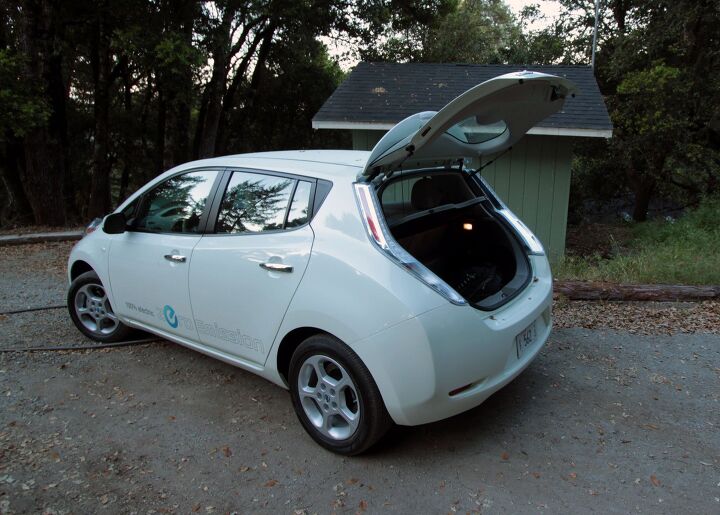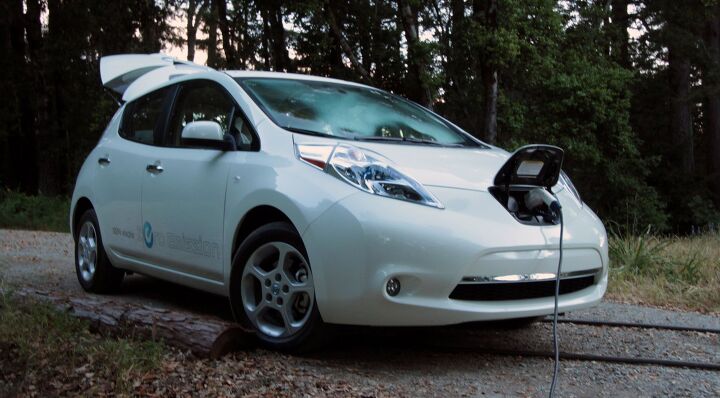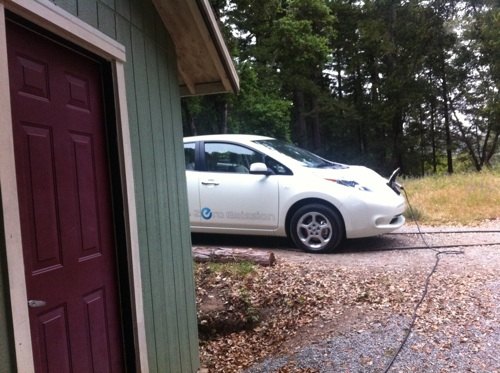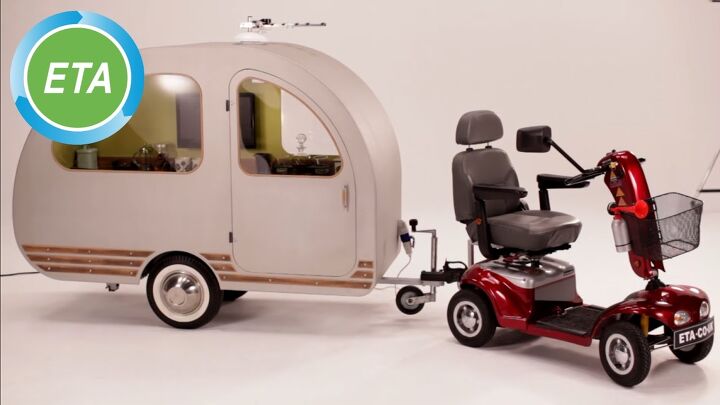#EV
BAIC To Deliver EV To Eager Beijing Buyers
When “Beijing’s car industry” (read: BAIC) put forward the suggestion to exempt EVs from the license plate lottery, and when that suggestion was adopted, those in the know said: “Great idea, bad timing.” Why? There are no EVs one can buy in Beijing.“Beijing’s car industry” (read: BAIC) is about to change that.
Review: 2011 Nissan Leaf: Day Three
The previous day’s usage had left me in a pickle. With the 12 miles left and only nine-and-a-half hours charging time at 120V. Of course if I constantly had to remind myself, if I had a 240V charging station at home this would be a non-issue as the Leaf would have been completely full. However, my situation as it was, the Leaf was perhaps a hair over 40% charged when I left for work with the range indicator displaying 59 miles, hopefully enough for my 57 mile drive.
Since I needed all the juice I could get to make it to Burlingame I decided to forgo the pre-heating and let the Leaf charge to the very last second. Fortunately this morning was a hair warmer than the day previous being a brisk 40 degrees. Unfortunately the temperatures and humidity conspired to fog the windscreen. Without sufficient power to make it to work and use the defogger, I chose to defog the old-fashioned way: windows open.
Feds Moving EV Tax Credits To "Cash For Clunkers" Model
Speaking at Nissan’s Smyrna, TN electric car factory, Transportation Secretary Ray LaHood noted that his staff is working with Congress to make federal tax credits for plug-in car purchases available as a rebate on the dealer level, saying
We’d like for people to get a $7,500 rebate on the day they buy the Leaf. We’re doing a lot of talking about it. When you give people that incentive to buy a battery-powered car, they’ll do it. We know these incentives help.
Speaking to Automotive News [sub], LaHood even went as far as to argue that the new direction for the tax credits, which were previously only claimable when filing taxes, would be successful for the reason that it would make the credits more like the Cash For Clunkers program. Apparently LaHood has completely forgotten how riddled with waste, inefficiency, fraud, confusion, delays, unintended consequences and all-purpose madness that program was. And that’s just scraping the surface. Foolish as it is to subsidize vehicles during the “fleecing the early adopters” phase of a new technology rollout (perhaps we should be saving stimulus for the inevitable “trough of disappointment”?), making those credits available at the dealer level is even worse, increasing the hype and incurring C4C-like downsides along the way.
Review: 2011 Nissan Leaf: Day Two
Our second day with the Leaf gave us a chance to really dive into the charging realities of driving an electric vehicle. Most of us are used to filling up our car when the tank is empty or well on the way to empty. If you are shopping for an electric car, throw this mentality out with the oil changes. Think of your car like a 1990s cell phone: plug it in often if you want to be able to use it later.
Review: 2011 Nissan Leaf: Day One
When I was a kid I was told that by the time I was 30 we would all be piloting nuclear powered flying cars. Reality, of course, has dictated that gasoline is still the most cost effective way of delivering what the average person considers a “normal driving experience.” In an attempt to change not just how we “fuel” a car, but the very way a car is integrated into our lives, Nissan has released the first volume produced electric car in North America. Yea, yea I know about the GM EV1, Toyota Rav4 EV and the Ford experiments, but let’s be real, Nissan has already sold more Leafs (Nissan tells me the plural is not Leaves) in the first few tsunami-effected months of this year than GM sold during the two years of EV1 production. How did they do it? We borrowed a white Leaf for just under three days to find out why 20,000 have already pre-ordered one of these pure-electric cars.
Carlos Ghosn: The EV Will Set You Free (It's The Battery, Stupid)
Further on today’s results conference at Nissan, I could regale (or most likely bore) you with what you will hear from just about any Japanese carmaker, and possibly from non-Japanese carmakers as well: Last year was a good year, the March 11 tsunami makes this year a challenging year, but what will not kill us makes us stronger, and in ancient China, crisis and opportunity were one and the same.
Now this is Nissan and Carlos Ghosn who has bet a farm in France and one in Japan on the future of the electric car. Ghosn made a few points today that are well worth noting. He talked about nukes, CO2, blackouts – and batteries.
What's Wrong With This Picture: Fixing Transportation Edition
President Obama devoted his weekly address to energy and transportation policy this week, speaking to the nation from an Allison hybrid bus transmission plant in Indiana. A White House blog post accompanying video of the President’s speech included a large infographic on “The Obama Energy Agenda And Gas Prices,” the transportation-oriented section I’ve excerpted above. This one section is actually a fairly good representation of Obama’s auto-related energy policy preferences, and illustrates why I often find myself criticizing the president here at TTAC.
Trade War Watch 18: DetNews Fumbles With The Saber
Just over one week ago, a Detroit News piece pointed me towards a letter written by Senators Carl Levin and Debbie Stabenow, which took China to task for considering draft legislation that might possibly require more technology transfers to Chinese companies as a precondition to market access. Having chased down both the letter and the US National Trade Estimate it was based on, as well as several reports on the draft legislation itself, I wrote a lengthy piece about how Senators Levin and Stabenow were rattling the saber about what appeared to be a complete non-issue. In that piece, I not only debunked the senators’ concerns, but I also pointed out that China’s local consumer EV subsidies were the far more worrying potential trade barrier, as we have been hearing that they require that all qualifying EVs be built in China and sold with Chinese brands (a condition at odds with at least the 2004 version of China’s Auto Industry Development Plan, which stated “local governments should encourage fair competition among motor vehicles made by different places on the local market. They are not allowed to carry out any discriminative policy or measure which may lead to discrimination against non-locally manufactured automobile products.”). And it turns out that my 2,000+ words didn’t put everyone to sleep, as a new DetNews piece re-reports the Stabenow/Levin letter with the inclusion of a new motivation never mentioned in their actual letter, to wit:
For electric or plug-in vehicles to qualify for incentives under the proposed rules, they must be produced in China — by a Chinese carmaker or in a joint venture with a Chinese company
Ignoring for a moment that this wasn’t explicitly mentioned in the letter, there’s another issue here: subsidies aside, building any car in China requires a joint-venture. More importantly, China need not establish any barriers to the sale of imported plug-in or hybrid cars for the simple fact that the Toyota Prius’s epically weak sales there prove that imported NEVs can’t compete in the market. Of course subsidies may change that, but even more important is the issue of registration limits: if China requires EVs to be locally-made in order to waive Beijing’s registration restrictions, that could create more of a barrier than any cash subsidy. Meanwhile, neither Daimler nor Toyota nor VW nor BMW seems to have a problem with building EVs locally under a JV (cost and supply chain make Chinese production the logical choice anyway, necessitating a JV). The DetNews (and presumably Senators Levin and Stabenow) are getting closer to understanding the problems with China’s New Energy Vehicle Plan, but it seems they may yet have some more TTAC reading to do.
What's Wrong With This Picture: The Rugged EV Lifestyle Edition
Of all the barriers standing in the way of commercial success for electric cars, the “image issue” is perhaps one of the least understood. Most EV firms have embraced the distinctively Western “green consumption” trend, in which a kind of environmental asceticism drives consumer values of downsizing and ultimately self-denial. But making a conscious choice to not use gasoline and accepting whatever the market happens to offer is not a phenomenon that automakers can expect to sustain itself. If they ever want to achieve mass acceptance, EVs need an image context that goes beyond graywater recycling, “freeganism” and other highly conscious but ultimately self-denying lifestyle choices.
Racing is one obvious way to broaden EV appeal, as it highlights the positive performance aspects of EV drivetrains, but sadly no major OEM will commit to an EV racing series. Besides, racing hardly builds on the existing (if limited) green appeal of EVs. Enter the EV as disaster response vehicle. The NYT has a fantastic story about the use of EVs in rescue efforts after the Japanese quake/tsunami, when gas was largely unavailable. The story proves that EVs, far from being mere lifestyle accessories, can be hugely useful in the right circumstances. And because so many green lifestyle choices stem from a perspective of apocalyptic expectation, this story both broadens and builds on the EV’s existing appeal. Most importantly of all, pictures like the one above will do more to banish the limp-wristed, “anti-luxury” image that curses EVs than just about anything else. Just as SUV buyers would swell with pride seeing an ad image of their Explorer in off-road conditions they would never visit themselves, the image of EVs running first-responder missions in a quake-torn Japan could be of lasting significance.
Best Buy Eyes EVs
Electronics retailer Best Buy raised a few eyebrows when it began selling Brammo electric motorcycles alongside its flatscreens and Xboxes a few years back. Two years after that agreement was announced, however, Brammos are sold at only three West Coats Best Buys (one here in Portland, OR, two in California) and Brammo is expanding its own dealership network independently of the big box chain. Was Best Buy’s Brammo experiment a disappointment? If so, it’s not stopping the retailer from pursuing other electric vehicle opportunities, as Best Buy’s mobility and transportation honcho Chad Bell tells Automotive News [sub] that it’s talking to electric car firms about a possible retail deal.
We are having conversations with some of the startups. I would say the conversations are going well. We are very excited about several partnerships that we can’t talk about yet. We probably get more traffic in a weekend than some of these dealers do in a month. The benefits for a small automaker trying to cobble together a sales and service network are obvious.
And despite the emphasis on startups and his use of the term “cobble together,” Bell insists that electric mobility is a long-term strategy for Best Buy.
According to Bell, even business opportunities like contracts for special EV customer training for dealerships are a possibility. But the shape of EV dealership experiences is still unclear, as (for example) Tesla has insisted that it doesn’t need a widespread dealer network because EVs need “next to no maintenance.” But clearly EVs aren’t fundamentally different from gas-powered cars in their needs for a service network. For example Tesla has not been able to deploy a multi-speed EV transmission on its Roadster (in fact, Brammo just announced what appears to be the first geared electric vehicle), and even its single-speed Roadster needs a $1,000 annual “tune up.” As geared EVs become more common, their maintenance and service needs will likely increase, and doing without dealers will become less of an option. Whether Best Buy and its “Geek Squad” can step into that breach (let alone actually sellelectric cars) remains very much to be seen.
Plug-In EVs Without The Plug
Two years ago, The Guardian found a strange barrier for the acceptance of EVs: Iugophobia, or the fear of plugging in. “Consumer research revealed that 61 percent of potential electric car customers were most worried about the inconvenience of recharging.” As an answer, connectorless inductive charging has been developed both in Japan and in Germany. The same electromagnetic field technology used to charge an electric toothbrush can charge an EV in a special parking bay without the need for wires. The Germans, usually not overly excited about EVs, did what they do best: They created a standard for inductive charging.
What's Wrong With This Picture: How Not To Change The Industry Edition
Electric car makers like to make a big fuss about how their clean-green automobiles are going to “change the industry.” Sometimes those instincts lead to hubris and overreach (ahem, Tesla), while other times the changes make you long for the relative simplicity of the new car dealer fandango we all go through to buy “regular cars.” In the case of Think, the business innovations (namely the innovation of relying on accumulating local tax credits to get the price to seem as low as possible) are enough to make the world of dealer markups and delivery charges seem downright quaint and homey. And that’s not the way to change this business…
How Efficient Are Plug-In Cars? Survey Says…
A number of plug-in hopeful firms have been testing their future products in fleets, keeping a close eye on the data coming back as they prepare for their consumer launches or wider availability. One such vehicle, Toyota’s plug-in Prius has been testing for some time now, and while the results of US and European testing hasn’t been publicized yet, Wards Auto reports that the company has disclosed the results of Japanese testing with some interesting conclusions. With BYD and Chevrolet releasing data from their own plug-in testing, we should have the basis for some interesting insights. Hit the jump for more on the lessons learned and the data gleaned from this testing of next-gen drivetrains.
Cure For Range Anxiety Found?
Trade War Watch 16: US Doesn't Understand China's EV Policy, Rattles Saber Anyway
George Orwell’s warning, that “the first victim of war is the truth,” apparently applies equally to trade wars. On Friday, Senators Carl Levin and Debbie Stabenow (both D-MI) wrote the United States Trade Representative to express their concern over “reported draft regulations” of China’s New Energy Vehicle plan, noting
We are concerned that these draft regulations continue China’s long history of breaking international trade rules.
Given that the ongoing low-level trade war between the US and China, this was a predictable bit of saber-rattling. But if Levin and Stabenow’s political motivations are easy to understand, the logic that leads them to believe China’s New Energy Vehicle plan is a violation of international trade rules is not. Meanwhile, neither the Senators nor the USTR appear not to have heard about another, more serious possible trade issue arising from China’s headlong dash towards electric vehicles. Sounds like a job for The Truth About Cars…





















Recent Comments